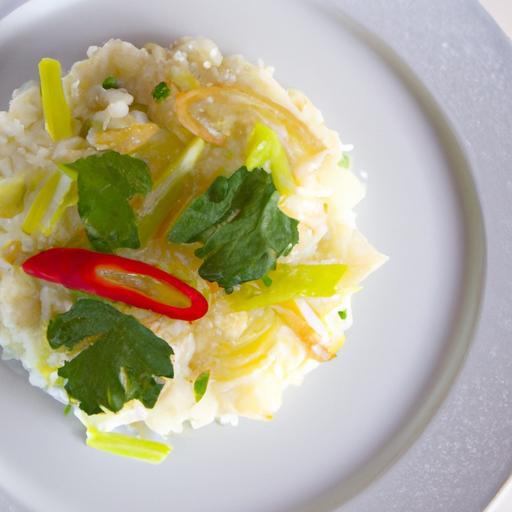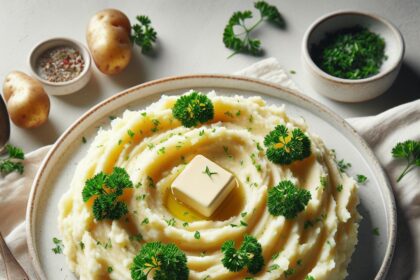There’s something undeniably comforting about a bowl of perfectly fluffy rice-each grain tender, separate, and inviting. Yet, when it comes to reheating leftovers, that delightful texture often betrays us, turning into an unappetizing clumpy mess. Fear not, rice lovers! In this article, we’re diving into the art and science of reviving your rice to its original cloud-like glory. Discover simple, foolproof tips to warm up your rice without sacrificing fluffiness, ensuring every bite is as delicious as the first. Say goodbye to sticky, hardened grains and hello to a reheated rice revival that will transform your leftovers into a culinary delight!
Fluffy Rice Revival: Easy Tips to Reheat Without Clumps transforms your leftover rice into a light, airy delight by unlocking the science behind perfect moisture control and the best reheating methods. Whether it’s jasmine, basmati, or sticky rice, reviving that fluffy texture is a kitchen art – one that balances moisture, heat, and technique to prevent stubborn clumps and dryness. From my experience rescuing countless plates of cold rice, mastering this is a game-changer for effortless meal prep and great-tasting leftovers.
Prep and Cook Time
Prep Time: 5 minutes | Cook Time: 10 minutes | Total Time: 15 minutes
Yield
Serves 2-3 as a side dish
Difficulty Level
Easy
Ingredients
- 2 cups cold cooked rice (preferably refrigerated overnight)
- 1-2 tbsp water, vegetable broth, or coconut milk (to add moisture)
- 1 tsp neutral oil or melted butter (optional, helps separate grains)
- Pinch of salt (optional)
Instructions
- Fluff the rice gently with a fork or chopsticks to break up any large clumps before reheating. This helps distribute moisture evenly and prevents clumping.
- Transfer rice into a microwave-safe bowl or skillet if reheating on stovetop.
- Sprinkle 1-2 tablespoons of water or broth over the rice to add essential moisture that plumps the grains during heating without making them soggy.
- If reheating in the microwave, cover the bowl with a damp paper towel or microwave-safe lid to trap steam and keep rice moist.
- Heat on medium power for 1-minute intervals, fluffing the rice gently between each cycle until hot but still light and separated – about 3-4 minutes total.
- For stovetop reheating, warm 1 teaspoon of oil or butter over low-medium heat, add the rice, and gently toss with a spatula for 5-7 minutes. Cover partially to retain steam, stirring occasionally to avoid sticking and to maintain fluffiness.
- Taste and adjust salt if needed, then serve immediately for the best texture.
Chef’s Notes: Tips for Success
- Choose the right rice: Medium and long-grain varieties tend to fluff better when reheated; short-grain or sticky rices require more delicate handling.
- Moisture matters: Avoid adding too much liquid at once; incremental spritzes work best to judge texture.
- Use steam: Covering your rice during reheating traps steam that revives texture-don’t skip this step!
- Flavor boost: Stir in herbs like cilantro, chopped scallions, or a squeeze of lime after reheating for a fresh finish.
- Storage tip: Cool rice quickly after cooking, store in a sealed container in the fridge, and consume within 3 days for optimal quality and safety.
- For bulk reheats, spreading rice on a baking sheet and warming in a low oven (300°F/150°C) for 10 minutes with a light mist of water can evenly fluff large quantities.
Serving Suggestions
Serve your freshly revived fluffy rice as a perfect alongside:
- Spicy stir-fried vegetables topped with toasted sesame seeds
- Grilled chicken or tofu drizzled with soy-ginger sauce
- A colorful curry with fresh cilantro garnish
- Lightly toasted nuts and shredded coconut for a tropical twist
The light texture allows rice to soak up sauces beautifully, making every bite a joy.
| Nutrient | Per Serving (1 cup) |
|---|---|
| Calories | 205 |
| Protein | 4.3 g |
| Carbohydrates | 45 g |
| Fat | 0.4 g |

Want to explore more about perfectly cooked rice? Check out our Perfect Rice Cooking Techniques for foundational skills. For science-savvy chefs craving deeper insights, the Science Daily article on starch retrogradation offers a fascinating explanation of why rice clumps and how moisture plays a starring role.
Q&A
Q&A: Fluffy Rice Revival – Easy Tips to Reheat Without Clumps
Q1: Why does reheated rice often turn clumpy and sticky?
A1: When rice cools down, its starch molecules crystallize and stiffen, causing grains to stick together. Reheating without proper moisture and heat distribution can make those clumps worse, turning your fluffy rice into a dense, gummy mess.
Q2: What’s the secret to fluffy, revived rice when reheating?
A2: The secret lies in reintroducing moisture and gentle heat. Adding a splash of water, broth, or even a light drizzle of oil before reheating helps steam the grains back to life, separating them into fluffy, tender bites instead of stubborn clumps.
Q3: Can I reheat rice safely without drying it out?
A3: Absolutely! Covering the rice during reheating traps steam, keeping the grains moist. Whether you microwave, steam, or pan-fry, a tight lid or microwave-safe cover ensures the moisture stays put, reviving rice’s soft texture without drying it out.
Q4: Is microwave reheating the best method for fluffy rice?
A4: Microwaving is fast and convenient if done right! Sprinkle a bit of water over the rice, cover it loosely (a damp paper towel works wonders), and microwave in short bursts, fluffing in between. This method steams the rice evenly-your quickest route to fluffy revival!
Q5: Can a stovetop help in reheating rice without clumps?
A5: Yes! Heating rice over low heat with a splash of water or broth in a non-stick pan and stirring gently helps separate grains and prevents burning. Covering the pan traps steam, ensuring every grain stays light and fluffy.
Q6: How can I prevent rice from clumping when storing leftovers?
A6: Spread out cooked rice on a shallow tray or plate to cool quickly and evenly before storing. Store it in an airtight container to keep moisture balanced. Avoid packing rice too densely in containers so the grains don’t smoosh together and stick.
Q7: Are there any quick hacks for reviving leftover rice?
A7: Try these: Add a pat of butter or a teaspoon of oil for smoothness, mix in a sprinkle of sesame seeds or chopped herbs to freshen flavor, or steam the rice over a pot of simmering water with a lid on for a gentle, thorough heat that fluffs each grain like new.
Q8: Does the type of rice matter when reheating?
A8: Yes, grains differ! Jasmine or basmati rice, with naturally drier grains, tend to reheat fluffier with less fuss. Sticky sushi or short-grain rice clumps more easily and benefits greatly from added moisture and careful steaming for the best texture.
Q9: Can reheating rice more than once affect its texture?
A9: It can. Multiple reheats dry out rice and make clumping worse. It’s best to reheat only what you’ll eat to preserve ideal texture and avoid food safety risks.
Q10: Any final golden rule for fluffy rice revival?
A10: Treat leftover rice like a delicate flower-gentle heat, plenty of moisture, and a little patience go a long way in bringing back its fluffy charm. With these tips, stale, clumpy rice can bloom anew with soft, separated grains ready to impress!
Closing Remarks
Reviving fluffy rice is more than just a kitchen trick-it’s an art that transforms leftovers into a delicious staple once again. With these simple reheating tips, say goodbye to clumpy, dry grains and hello to moist, pillowy perfection every time. Whether you’re warming up last night’s dinner or prepping meals ahead, mastering the fluff factor ensures your rice always shines as the perfect side or base. So next time you reheat, remember: a little steam, gentle heat, and mindful stirring can bring your rice back to life-fluffy, fresh, and ready to delight your palate all over again.








